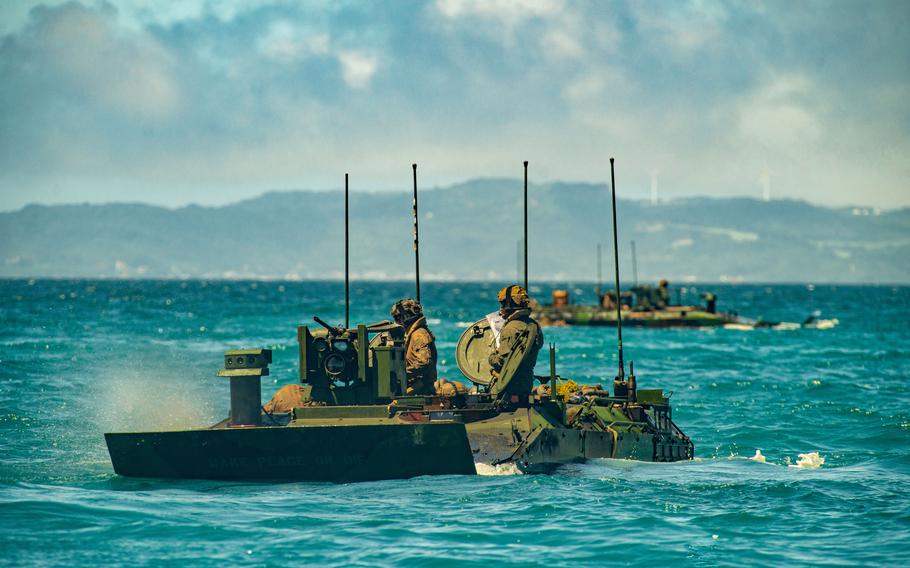The US Marine Corps executed its first overseas ship-to-shore operations with the new Amphibious Combat Vehicles (ACVs) on June 24, 2024, at the White Beach Naval Facility in Okinawa, Japan.
The event also marked the first trip for the Marines stationed in Okinawa aboard the new amphibious vehicles. The service said that Marines and sailors from the 15th Marine Expeditionary Unit (MEU) reached White Beach Naval Facility, partly traversing on the newly deployed ACVs.
The soldiers of the 15th MEU embarked on the amphibious dock landing ship USS Harpers Ferry (LSD 49) and arrived at White Beach on June 18 for a port visit and to conduct essential sustainment training.
During the ship-to-shore operation, personnel boarded the ACVs before they emerged from the well deck of the Harpers Ferry. Boats from the 3rd Expeditionary Operations Training Group then maneuvered alongside the ACVs to transfer personnel to a pier, simulating safety egress procedures.
After transferring all personnel, the ACV Platoon navigated through the boat basin to come ashore at White Beach, where they conducted maintenance.

US Marine Corps Lt. Col. Nick Freeman, commanding officer of BLT 1/5, 15th MEU said, “This was fairly standard training for us, but I’m proud it also represented the first overseas ship-to-shore employment of ACVs.”
“We’ll continue to train at other locations in the months ahead, using a deliberate approach, capturing useful data and lessons learned, and ultimately sharpening our understanding of how to best employ the ACV in its intended environment – embarked with our forward-deployed ARG/MEUs,” Freeman added.
Before the ship-to-shore movement, the Marines showcased the ACVs on the Harpers Ferry to other Marine units and members of the Japan Self-Defense Force.
The 15th MEU is part of Task Force 76, the expeditionary warfare arm of the U.S. 7th Fleet headquartered at Yokosuka Naval Base, Japan. Rear Adm. Chris Stone, commander of Task Force 76 and Expeditionary Strike Group 7 commended the ACVs as a “force multiplier” that significantly enhances operational flexibility and response capabilities in maritime environments.
The ACVs’ first operational deployment was in May during the Balikatan exercise in the Philippines. In those drills, the 15th MEU utilized the ACVs for live-fire exercises at a waterborne range in Oyster Bay, Palawan.
The ACV platoon launched from the USS Harpers Ferry organized into assault sections and engaged multiple shore-based targets using their Remote Weapons Systems with Mark 19 40 mm grenade machine guns.
New Marine Corps amphibious vehicle
The US Marine Corps is transitioning to the new Amphibious Combat Vehicle (ACV) replacing the aging and problematic amphibious assault vehicle. This shift follows a tragic mishap in 2020 that claimed the lives of eight Marines and a Navy corpsman on the West Coast.
BAE Systems, based in York, Pennsylvania, led the development of the ACV. In June 2019, the company received a $67 million contract. Subsequently, the company secured a $184 million contract for the vehicle’s full production.
Despite these advances, the ACV has encountered its own set of challenges. The vehicle’s repeated rollovers during training exercises have presented a significant challenge for the Marine Corps.
In October 2022, an ACV rollover occurred without resulting in fatalities, leading the Corps to restrict the vehicle’s operations. Earlier that same year, in July, two ACVs became disabled off the coast of Camp Pendleton, California, though no injuries were reported.
Tragically, a Marine from the 15th Marine Expeditionary Unit (MEU) lost his life in December 2023 during a training accident at Camp Pendleton when an ACV rolled over.
:quality(70)/cloudfront-us-east-1.images.arcpublishing.com/archetype/7HGY5NE5X5BODIRG4TY4CY6DCA.jpg)
The Marine Corps has identified insufficient training on the ACV’s operational differences from its predecessor as the root cause of these incidents. Unlike the older vehicle, the ACV features wheels instead of tracks, a flatter hull, and a smaller size, among other design changes.
There are also concerns regarding the ACV’s wheeled design, which experts argue does not provide a speed advantage over the Cold War-era tracked Assault Amphibious Vehicle in water. The Marine Corps aims to address this with a “Phase 2” ACV that will potentially meet these performance requirements.
Nevertheless, the eight-wheeled ACV is designed to significantly enhance the Marine Corps’ capability to transport troops to shore. These vehicles are deployed from ships and can navigate through surf close to shore during assaults and landings.
The deployment of the ACV is a critical step in modernizing the Marine Corps’ capabilities in the Pacific theater. The region is a strategic focus as the Marines prepare for the possibility of a large-scale conflict with China, where amphibious operations will play a crucial role.
- Contact the author at ashishmichel(at)gmail.com
- Follow EurAsian Times on Google News




